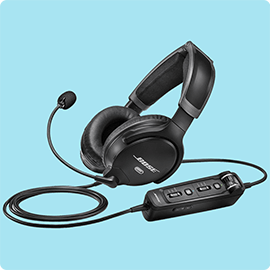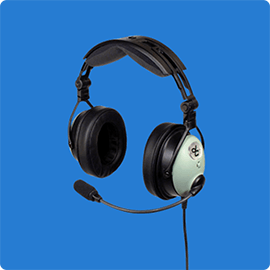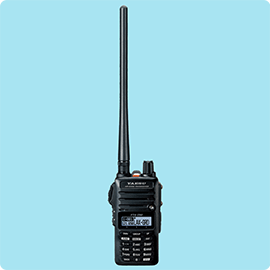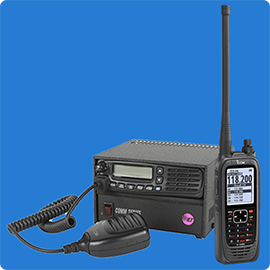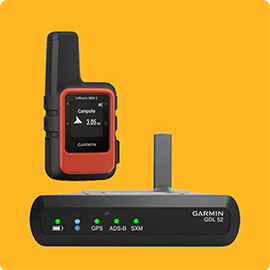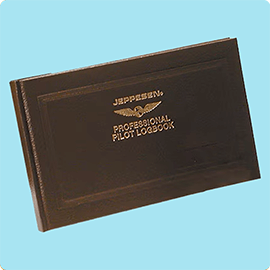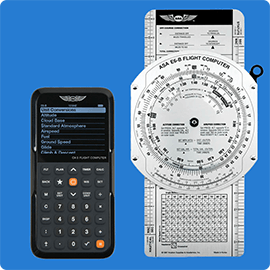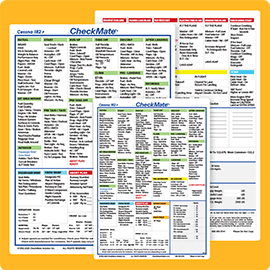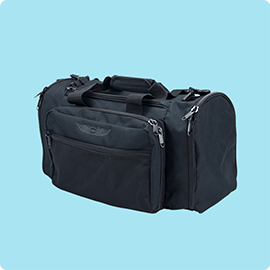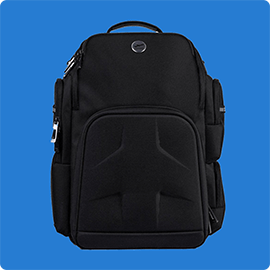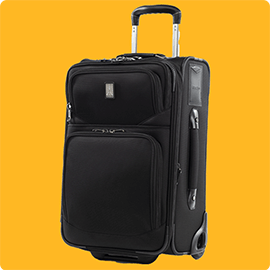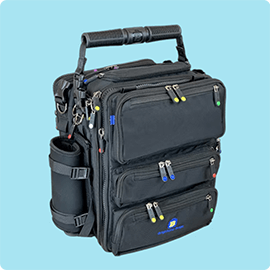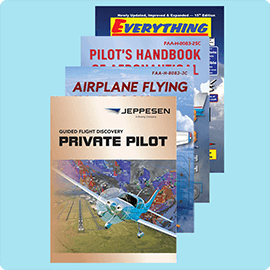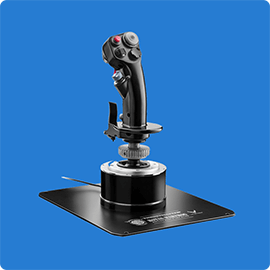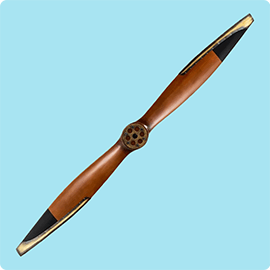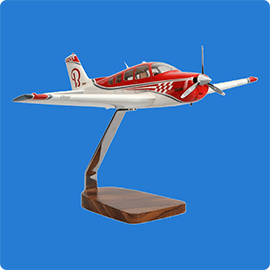The Two Types of Reliability Every Pilot Needs
Every pilot needs a reliable handheld radio, but "reliable" can mean two different things. Is it the rock-solid, simple-to-use toughness of an Icom that never fails? Or is it the feature-packed, versatile capability of a Yaesu that acts like a co-pilot in your palm? This complete guide breaks down the pros and cons of these two leading brands, with a detailed comparison chart and a pilot-focused FAQ to help you choose the perfect backup for your flight bag.

Featured Pilot Gear
Browse our selection of high-quality pilot supplies! Your purchase directly supports our small business and helps us continue sharing valuable aviation content.
Every pilot carries a preference for reliability. For some, it’s a radio that simply refuses to quit. For others, it’s a handheld that packs extra tools for the “what‑ifs.” Here’s how to choose the one that matches your flying.
Contents
Why Every Pilot Needs a Reliable Handheld Radio
Picture this: you’re sailing along on a cross‑country when your panel comm suddenly goes quiet. No sidetone, no ATC. That’s when a handheld transceiver earns its keep. It’s your belt‑and‑suspenders safety net, ready to restore comms, copy ATIS from the ramp, coordinate on the ground, or let students practice real‑world phraseology without firing up the avionics.
Reliability, though, wears two faces in the handheld world:
Rugged Simplicity: A radio that always turns on, transmits clearly, and shrugs off abuse.
Versatile Capability: A radio that layers NAV, GPS, and smart touches onto solid COM performance.
Icom – The Rock‑Solid Pro’s Choice
Icom is the definition of “trusty backup.” The brand’s philosophy is simple: make a tool that works every time. Many models are built to demanding durability standards and are sealed against weather. Controls are straightforward, displays are easy to read in bright cockpits, and audio is loud and clean so you can actually hear ATC over the engine.
Why pilots reach for Icom
- Legendary ruggedness: Tough housings, weather resistance, and testing that focuses on drops, vibration, and temperature.
- Clarity in noise: Strong audio output and clean receive quality help cut through cockpit chaos.
- Battery staying power: Long runtimes from Li‑ion packs, plus optional AA trays on many models to keep talking if the rechargeable runs flat.
- No‑nonsense UI: Big buttons, smart “flip‑flop” frequency recall, and one‑press 121.5 on applicable models.
When everything else fails, an Icom won’t. That’s the point of rugged simplicity.
Yaesu – The Feature‑Packed Navigator
Yaesu takes a different route: reliability through versatility. Start with a solid COM radio, then add tools that help when the day gets interesting. Many Yaesu models include NAV (VOR/LOC/ILS) and some add integrated GPS with waypoints and nearest‑airport functions. Select models include Bluetooth for wireless headsets or programming.
Why pilots pick Yaesu
- NAV/COM in your hand: Tune VORs, see course deviation, or monitor ILS-all without touching the panel.
- GPS on select units: Waypoints, position readouts, and “nearest” can bolster situational awareness when avionics go dark.
- Training & versatility: CFIs like the flexibility; tech‑minded pilots appreciate having multiple tools in one device.
- User‑friendly: Icon‑driven menus and smart layouts keep the learning curve reasonable.
A Yaesu isn’t just a radio; it can feel like a co‑pilot in your palm.
Icom vs. Yaesu: Comparison Chart
Examples below use popular models. Exact features vary by variant and production run-always confirm on the product page.
| Feature | Icom A16 | Icom A25N | Yaesu FTA-550L | Yaesu FTA-850L |
|---|---|---|---|---|
| Core Type | COM‑only | NAV/COM | NAV/COM | NAV/COM + GPS |
| Transmit Power | “6 W‑class” handheld power | “6 W‑class” handheld power | “5–6 W‑class” handheld power | “6 W‑class” handheld power |
| NAV / ILS | - | VOR/LOC/ILS (model dependent) | VOR/LOC/ILS | VOR/LOC/ILS with on‑screen CDI |
| GPS | - | Built-in GPS with Simplified Waypoint NAV |
No | Integrated GPS (waypoints/nearest) |
| Power Options | Rechargeable Li‑ion; optional AA tray | Rechargeable Li‑ion; optional AA tray | Rechargeable Li‑ion; AA version available | Rechargeable Li‑ion; |
| Durability | Weather‑resistant; built for knocks | Weather‑resistant; tested to demanding standards | Weather‑resistant; solid build | Weather‑resistant; color display |
| Standout Strengths | Very loud audio; simple UI; long endurance | Big display; one‑touch 121.5; robust build | Great value NAV/COM; intuitive menus | Bluetooth on select versions; feature‑rich |
| Best For | Rugged backup, rentals, trainers | IFR flyers wanting simple, tough NAV/COM | Budget‑friendly all‑in‑one backup | Tech‑forward pilots, CFIs, redundancy lovers |
Frequently Asked Questions
How far will a handheld aviation radio transmit?
Handhelds are VHF line‑of‑sight. From the air, expect ~8–10 NM easily and often much farther at altitude (20–30+ NM). On the ground, range drops due to terrain and structures. Antenna quality and holding the radio near a window help. Connecting to an external aircraft antenna (if possible) can dramatically extend range.
Can I use a handheld as my primary radio?
It’s legal for many operations and common in gliders, ultralights, or antiques, but in certified GA airplanes a handheld is best as a backup. Installed radios with external antennas outperform handhelds and integrate with your intercom/audio panel. If the panel fails, a handheld can absolutely get you down safely.
How long do the batteries last?
Most modern units deliver a full day of mixed use on their Li‑ion packs (often in the 8–12 hour ballpark with light transmit). Heavy transmitting shortens runtime. Keep the pack topped off and consider a spare or an alkaline tray for long days.
Is there a benefit to built‑in GPS or NAV?
Yes, especially as a last‑ditch backup. NAV (VOR/LOC/ILS) can provide course guidance if your panel goes dark. GPS on select models adds waypoints and “nearest airport” for situational awareness. If you already fly with an EFB and panel GPS, these features are nice redundancy; if you don’t, they’re extra peace of mind.
Which power source is best as a true backup?
Alkaline AAs are the winner for emergency readiness. Li‑ion packs are great for daily use but slowly self‑discharge over time. A sealed pack of fresh alkalines in your bag will be ready months later. Many radios offer an AA battery tray add one to your kit.
What accessories should I consider?
A headset adapter (if not included), spare antenna or portable external antenna, AA battery tray, belt clip or lanyard, and a padded case. If your model supports it, a 12V ship or car charger is handy.
COM‑only or NAV/COM-how should I choose?
If you prize simplicity and maximum toughness, a COM‑only model is perfect. If you fly IFR or just want more layers of redundancy, a NAV/COM, and possibly GPS adds capability without adding another device to carry.
Any quick preflight tips for handhelds?
- Charge the Li‑ion pack before flight; check the AA tray’s expiration dates.
- Store last‑used and local frequencies for fast recall.
- Keep the radio and adapter where you can reach them with belts fastened.
- Do a quick radio check on the ramp (on an appropriate frequency) to confirm TX/RX and audio.
Conclusion: Choose Your Kind of Reliable
Some pilots want a radio that’s built like a brick and always, always works. Others want a pocket‑sized Swiss‑Army‑knife that can also navigate. Both paths are valid-and both make you safer than flying without a backup.


